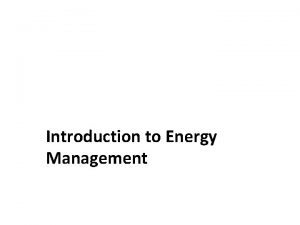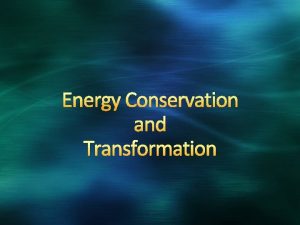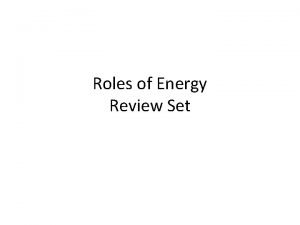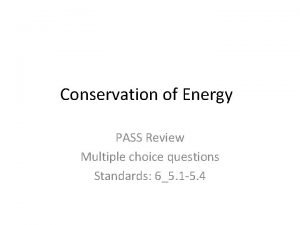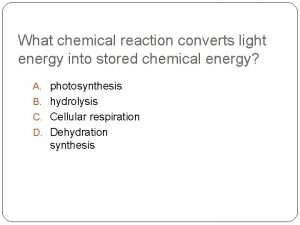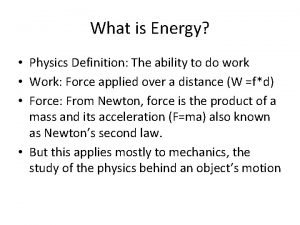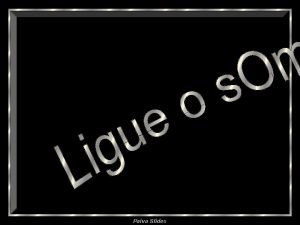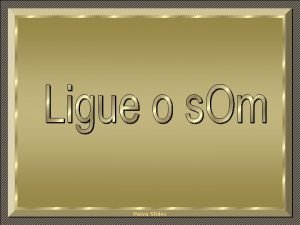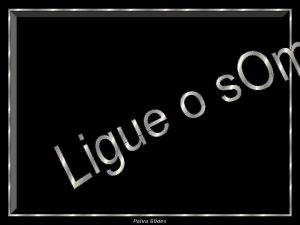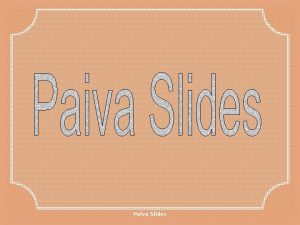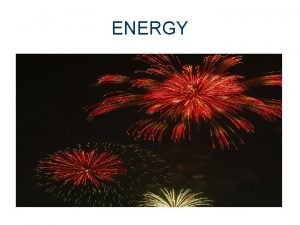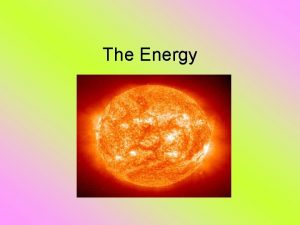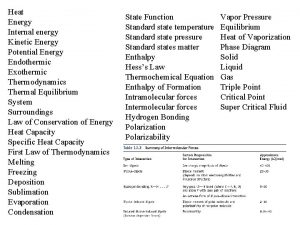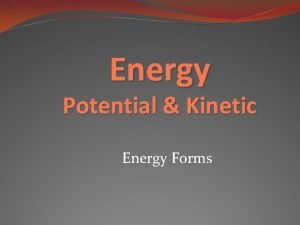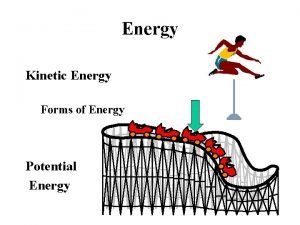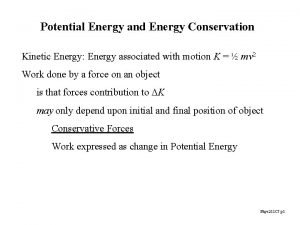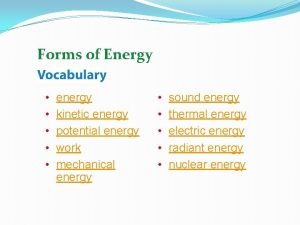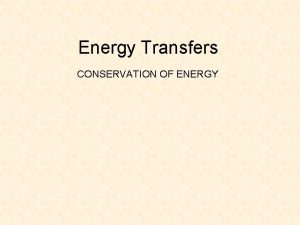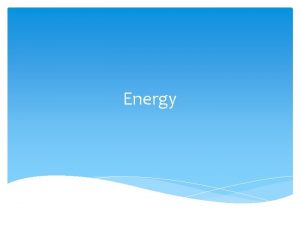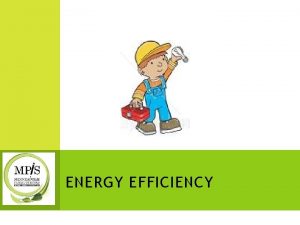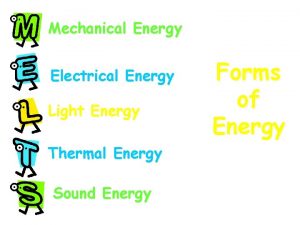Slides 4 Energy analysis ENERGY ANALYSIS Slides 4




























- Slides: 28

Slides 4 - Energy analysis ENERGY ANALYSIS

Slides 4 – Energy analysis Structure of a company's energy system Supply Conversion Distribution Consumption Heat recovery Disposal

Slides 4 – Energy analysis Energy efficiency Typical areas of improvement Ø Cooling/refrigeration Ø Heating Ø Compressed air Ø Insulation Ø Heat recovery Ø Separation processes Ø Lighting Ø. . .

Slides 4 – Energy analysis Efficient energy use Not only a question of best technology!

Slides 4 – Energy analysis Energy management ØOrganization Set up an organizational unit, identify responsibilities and determine the budget ØAnalysis and Planning Inventory and description of the energy situation search for energy saving options ØControl of the energy plants, work out energy indicators ØConsulting Energy reports, internal consulting and market analysis Ø Implementation of energy saving options maintenance of energy plants

Slides 4 – Energy analysis Documentation of load curves Documentation of curves for Ø A year Ø A week Ø A day Analysis of load curves Ø Winter – summer ratio Ø Combined use of heat and power Ø Switched off or reduced operation at weekends Ø Days with high energy demand Ø Bottlenecks Ø Energy demand after production

Slides 4 – Energy analysis Annual energy consumption Collection and documentation for all energy carriers Ø Quantity Ø Cost Ø Reference quantities Ø Definition of indicators Analysis and interpretation Ø Distribution of quantities Ø Distribution of costs Ø Variation of indicators Ø Comparison of indicators with other companies or publications

Slides 4 – Energy analysis Analysis of consumers Heat Electric power Ø Avoid partial load and use Ø Thermostatic valves adequate machines Ø Separate control of plants Ø Adapt power (e. g. fans) Ø Adequate temperatures Ø Optimize lights (cleaning, Ø No internal sources of heat modern lighting, analyse and humidity in cooled areas demand) Ø Use shades for heat protection Ø Clean and service (air filter, Ø Frequency-controlled fans nozzles, etc. ) Ø Use heat cascades Ø Compressor location and Ø. . . pressure Ø Peak load management

Slides 4 – Energy analysis Heat losses detected with an infrared camera

Slides 4 – Energy analysis Specific energy consumption 150 Example: Energy consumption of a brewery 125 Indicator: MJ/hl 100 Measure: June 1992 Installation of a vapour recompression plant

Slides 4 – Energy analysis Energy, work and power ØWork is the transmission of energy. ØThe unit of work and energy is JOULE. ØThe speed at which work is performed is power [J/s = W].

Slides 4 – Energy analysis Heat capacity To heat up a body with a mass of m by DT, the following amount of heat is required: Q = c m DT The specific heat capacity c of the material depends on the temperature. The specific heat capacity is the amount of energy required to heat up 1 kg of material by 1 °C. Specific heat capacity Gold Unit: [c] = 1 J. kg-1. K-1 Iron Oxygen Benzene Water

Slides 4 – Energy analysis The performance of 1 k. Wh Ø Lifts 1 ton of steel by 367 m! m Ø Accelerates a car (1 ton) to approx. 60 km/h (without losses 305 km/h)! km/h Ø Heats up 1 000 l of water by 0. 86 °C! °C Source: Karl Lummerstorfer, Energie Institut Linz

Slides 4 – Energy analysis Efficiency in a steam system Part of the steam system Steam boiler Efficiency (70 -) 82 – 90% Steam transportation 75 – 90% Heat exchange 85 – 98%

Slides 4 – Energy analysis Steam system Ø Reduce leaks. Ø Improve operation of steam traps. Ø Increase condensate recovery. Ø Increase flash steam recovery. Ø Use lower steam pressure if possible. Ø Use direct steam for heating if possible.

Slides 4 – Energy analysis Cooling process Efficiency = Qcond. / P ~ Tcond. / (Tcond. – Tevap. ) Consequences: Q: Heat P: Power T: Temperature ØThe lower the temperature difference the better: ØCheck the necessary cooling temperature ØAllow the temperature in the condenser to be as low as possible (e. g. water cooling) ØMaintain the heat exchanger (especially evaporator) Ø. . . ØThe higher the cooling temperature the better ØOthers: ØRemove water from ground ØAvoid high temperature of the incoming product Ø. . .

Slides 4 – Energy analysis Cooling process P Qu = Qo + P M Compressor Qo Evaporator Qu Condenser To Tu Collector Low pressure High pressure Efficiency = Qo / P = To / (Tu – To)

Slides 4 – Energy analysis Cooling and freezing Ø Raising the cooling temperature by 1 °C saves approx. 4% of electric energy. Ø Choose the adequate temperature: frozen meat at -20 °C, cooling at 0 °C to 4 °C. Ø Clean the condenser regularly and provide sufficient cool air supply. Ø Use the capacity of the storage rooms, collect goods, switch off unused cooling units. Ø Keep storage rooms closed to avoid entrance of humidity and warm air. Ø Defrost cooling rooms.

Slides 4 – Energy analysis Cooling – 2 Ø Insulation ØRecommendations for PU-foam insulation: Insulation thickness 0 to -8 °C 0 to -15 °C below -15 °C 80 mm 110 mm 150 mm Ø Evaporator: ØOptimize defrosting Ø Compressor ØClose to evaporator ØCentral location makes servicing and use of heat easier Ø Condenser: ØOutside of building, sun-protected ØClean regularly Ø Use R 134 a, R 22 or ammonia

Slides 4 – Energy analysis Drying process • Fresh air drying Q 1 • Fresh air drying with heat recovery 8 • Circulating air drying with/without heat recovery Q 4 Q 3 Ti • Heat recovery with condensation of humidity (heat pumps, thermo-compression) Td Q 2 QT Typical options for improvement: Q 1 = Insulation of drier Q 2 = Pre-drying, pre-concentration of the product Q 3 = Control of temperature and humidity Q 4 = Heat recovery, humidity control of flue gas, good housekeeping To

Slides 4 – Energy analysis Compressed air Ø Shut down compressor, drier and the network Ø Reduce the pressure level (as far as possible) Ø Avoid leakages Ø Lower the temperature of incoming air Ø Avoid compressed air for cleaning Ø Carry out maintenance Ø Use electrically-driven equipment Ø Foster heat recovery Source: Karl Lummerstorfer, Energie Institut Linz

Slides 4 – Energy analysis Lighting Ø Turn off when not needed Ø Use timer or motion detector Ø Use daylight as much as possible Ø Service and clean Ø Clean windows, ensure efficient design of rooms Ø Use energy saving bulbs

Slides 4 – Energy analysis Heat recovery cooling units – 1 Air-cooled condenser Water-cooled condenser Evaporator Compressor

Slides 4 – Energy analysis Heat recovery cooling units – 2

Slides 4 – Energy analysis ECOPROFIT-company: Brewery Annual production: > 1 million hl, ISO 14000 Ø Saving of water, energy and chemicals due to CP options: Cold filtering/sterilization New filling line Heat/power co-generation Vapour compression . . .

Slides 4 – Energy analysis Specific heat consumption of a brewery 50. 00 in k. Wh/hl 40. 00 30. 00 20. 00 10. 00 spec. heat 1993 1994 ´ 95 ´ 96 ´ 97 ´ 98 ´ 99 2000 2001 2002 38. 60 40. 67 47. 30 42. 62 41. 42 37. 56 34. 19 29. 91 27. 58 24. 47

Slides 4 – Energy analysis Multistage evaporation 1. evaporator 2. evaporator 1. vapour 3. evaporator 2. vapour condenser 3. vapour vacuum pump feed steam 1. concentrate steam condensate Source: Ignatowitz 1994 final concentrate 2. concentrate 1. vapour condensate 2. vapour condensate 3. vapour condensate

Slides 4 – Energy analysis Evaporation with vapour compression evaporator vapour preheated feed pre-heater steam (start-up) compressor vapourcondensate feed solution Source: Ignatowitz 1994 concentrate
 Energy energy transfer and general energy analysis
Energy energy transfer and general energy analysis Energy energy transfer and general energy analysis
Energy energy transfer and general energy analysis A small child slides down the four frictionless slides
A small child slides down the four frictionless slides A small child slides down the four frictionless slides
A small child slides down the four frictionless slides Mrt energy management slides
Mrt energy management slides Section 2 describing energy
Section 2 describing energy Potential energy
Potential energy Primary energy and secondary energy
Primary energy and secondary energy Primary energy and secondary energy
Primary energy and secondary energy Gibbs free energy non standard conditions
Gibbs free energy non standard conditions Unit of entropy
Unit of entropy Efficiency equation
Efficiency equation How are thermal energy and temperature different
How are thermal energy and temperature different A hairdryer converts ____ energy into ____ energy.
A hairdryer converts ____ energy into ____ energy. Electric potential energy formula
Electric potential energy formula How to convert mechanical energy to electrical energy
How to convert mechanical energy to electrical energy Chapter 5 thermal energy answer key
Chapter 5 thermal energy answer key How to find delta g
How to find delta g Helmholtz free energy and gibbs free energy
Helmholtz free energy and gibbs free energy As nutritional energy passes through the food chain it is
As nutritional energy passes through the food chain it is As a roller coaster goes downhill
As a roller coaster goes downhill Chapter 7 energy conservation of energy
Chapter 7 energy conservation of energy Indirect form of solar energy
Indirect form of solar energy ________ converts light energy into chemical energy. *
________ converts light energy into chemical energy. * Gravitational to kinetic energy
Gravitational to kinetic energy Energy example
Energy example Electric field and energy
Electric field and energy Energy physics definition
Energy physics definition Examples of mechanical energy at home
Examples of mechanical energy at home




